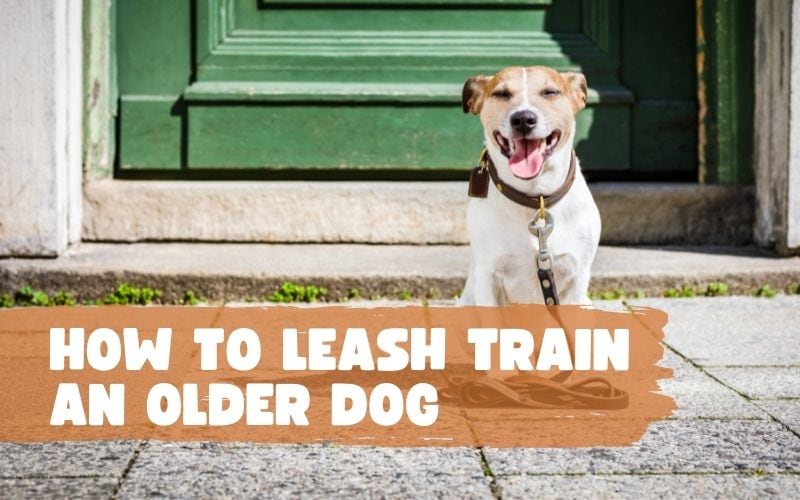Are you struggling to leash train your older dog? You’re not alone. Many pet owners find this process difficult, but it’s definitely doable with a little bit of patience. In this article, we’ll walk you through the step-by-step process of leash training an older dog. Let’s get started!
How to train a dog to walk on a leash?
If you’ve ever met one, you’re probably aware that dogs aren’t born knowing how to walk on a leash and must be taught. This is critical for you and your dog’s safety, as well as the safety of those around you. Unfortunately, many dogs tend to pull on the lead, which can be exhausting for you and potentially dangerous if the dog is big and powerful.
Don’t be disheartened if you have an older dog who has developed these undesirable habits; it’s never too late to train a dog to walk on a leash comfortably. All you need is time, patience, and an understanding of how a dog learns and obeys commands.
Step 1: Choose a suitable leash to train an older dog
While certain types of leashes come with durability advantages, the main goal here is to select the best leash for effectively training your dog. You’re taking your dog for a walk to break a negative behavior that could put you and the dog in danger. As a result, you’ll need a training leash to help your older dog improve its behavior.
If you are using the right kind of training leash, it can make it easier and faster for you and your dog to fix its undesirable habits. So, don’t be hesitant to change your ordinary leash for a training leash. This step can simplify the whole process.
Step 2: Understand why a dog pulls on the leash
The most common issue that owners have while walking their older dogs is the dog pulling on the leash. Dogs pull on the leash because they are excited to get outside, and their instincts instruct them to investigate their surroundings. If you relent and go in the same direction as he’s pulling, he’ll keep doing it. You are in fact encouraging your dog to continue to pull on the leash.
To break this tendency, stand firmly in place when he starts pulling on the leash and wait until he stops pulling and pays attention to you. You may need to repeat this several times before your dog understands that pulling the leash is counterproductive.
Step 3: Control the excitement of the dog on a leash
When you put the leash on the dog, you may notice an enthusiastic response. This is primarily due to the association of the leash with going on a walk. Excitement, on the other hand, might be detrimental because the more excited they are, the more difficult it will be to train them.
Desensitize the dog to the leash to lower the level of excitement. Just clip it on them and leave it without taking a walk. Do this for 10 to fifteen minutes in one go. After a few repetitions, the dog will learn to be relaxed when approached with the prospect of getting a leash.
Step 4: Avoid punishment while training a dog on a leash
Dog leash training may be a frustrating experience. Negative reinforcements from you will only result in a temperamental and frightened dog. Punishment should not be used to train a dog – whether old or young. Positive reinforcement and shaping are more effective. You want your dog to behave naturally and not because he is frightened of you.
Step 5: Train an older dog to walk on a leash with patience
Patience is one of the most crucial qualities to have while leash training an older dog. Throughout the process, you must be patient with both you and your dog. You must be able to maintain steady, uninterrupted walking. The point is, breaking your dog’s old habit will not be easy. Also, you need to remember that you are dealing with an old dog.
If you become frustrated and allow your dog to drag you to the park, for example, you will effectively erase all of your previous training efforts. The length of time it takes to thoroughly leash train differs for each dog. However, all dogs will get there if you are patient, consistent, and attentive during the training process.
Step 6: Reward the dog for its good behavior
Two things to remember while leash training a dog are rewards and praises, as dogs love them. So, when you begin your dog’s leash training, bring a few doggy treats with you. Reward your dog with his favorite treats whenever he walks calmly when on a leash.
This will impress upon him that it is the right thing to do. You can praise the dog when he has learned to walk beside you without pulling on the leash. Finally, when your dog is fully leash trained, try to limit the treats he gets.
Conclusion
It is better to train an older dog to walk on a leash beside you rather than pull the dog towards you when it pulls. In case your dog pulls on the leash, remain stationary until he stops pulling and sits down. Entice him to come closer to you with treats. Always remember not to drag or pull your dog with you.
If your dog barks or lunges at a distraction while on a walk, try to understand what triggers him to act in this manner. Avoid these types of stimuli by calling your dog’s attention to you before they become distracted by a particular stimulus.
